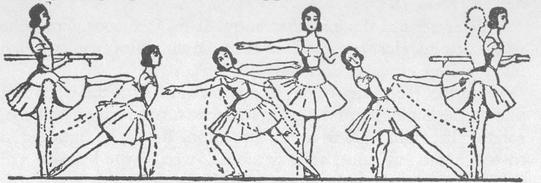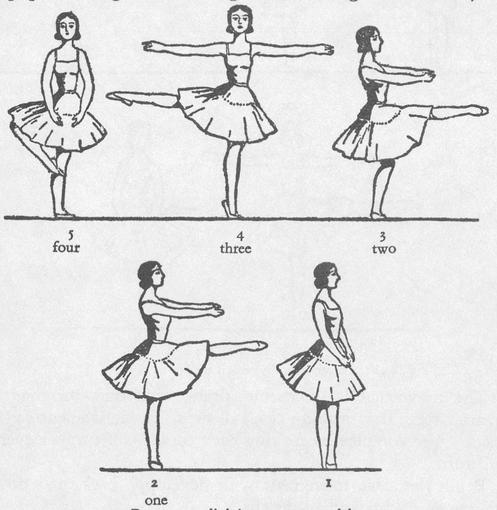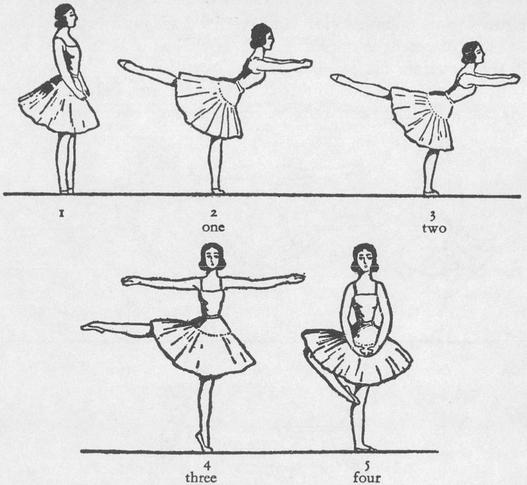Basic Principles of Classical Ballet (8 page)
Read Basic Principles of Classical Ballet Online
Authors: Agrippina Vaganova

Of the many forms of développé I shall describe the two most complicated.
BATTEMENTS DÉVELOPPÉS TOMBÉS
This battement, according to its type, belongs to small adagio . It is done mostly in the centre, but sometimes also at the barre. The movements are as follows:
Do a développé forward with the right leg, rise on half-toe, fall with the weight of the entire body into the deepest plié on the right foot; the left leg is extended and touches the floor with its toes only; transfer the weight back onto the left foot, while the right leg repeats the développé with a swift movement and returns to its open position, and the left rises onto half-toe.

20. Battements développés tombés
This battement is done forward, as well as to side, back, and in the directions croisé, effacé, écarté.
In order to give this movement a wider form, I always advise my pupils to imagine that the leg has to be flung over some object. This does not let the dancer lower herself too soon during the fall of the body. The result is a very wide battement and the leg is flung very far.

21. Battements divisés en quarts en dehors.
BATTEMENTS DIVISÉS EN QUARTS
This exercise is done in the centre. It may be considered one of the first adagios. It consists of the following movements which may be done en dehors and en dedans:
From the 5th position, développé forward with the right leg, plié on the left leg; turn the body a quarter-turn to left on half-toe, rotating the right leg into the 2nd position. Bring the right leg in to touch the left knee, and, without lowering the leg into 5th position, repeat the movement from the beginning.

22. Battements divisés en quarts en dehors
The movement is done four times, each time turning one quarter-turn, thus making one full turn. The movement can be made more complex by making each turn a half-turn or even a full turn.
17
Begin the same movement with développé back, and do all figures en dehors and en dedans.
III
ROTARY MOVEMENTS OF THE LEGS
RONDS DE JAMBE PAR TERRE
EN DEHORS. This movement begins from 1st position. The leg moves forward as in battement tendu; from here the toe describes an arc through 2nd position to a point opposite 1st position at the back. From this point the foot draws a straight line to the point from which it began the arc, passing through 1st position, with the heel lowered to the floor, and stretched-out knees.
En dedans. This movement is done in the opposite direction. The leg moves backward from 1st position and draws the same arc and straight line in the opposite direction, complying with the same rules. The movement is completed by placing the leg in 5th position forward.
When rond de jambe par terre is done in fast time, it is preceded by the following preparation:
From 5th position, move the right leg forward, doing a plié on the left leg, the arm going into 1st position. Draw the right leg into 2nd position, straightening the left knee and opening the arm into 2nd position.
If doing this movement in very fast time, when the foot cannot quite describe a full circle, in the movement en dehors the foot should reach its extreme point backward; and in the movement en dedans its extreme point forward.
The leg involuntarily goes astray and does exactly the opposite, i.e. en dehors it moves from 2nd position through 1st, forward; en dedans, from 2nd position through 1st, backward. This makes the movement too easy and does not provide the necessary work for the muscles.
RONDS DE JAMBE EN L’AIR
En dehors. From 5th position, the right leg is opened into 2nd position at 45°, the toes stretched out. From here the toe describes an oval (the long side in the direction of left to right), beginning with its backward arc. When the knee is bent and the toe is drawn in to the calf, but not under the knee, it should not reach beyond the calf of the left leg, either forward or backward. The hip-leg joint (pelvic arch) remains immobile, and thus the upper part of the leg, from the knee up, is also immobile.

23. Rond de jambe par terre and en l’air
En dedans. In the movement en dedans, the foot begins to describe the oval from its forward arc and, completing the movement, is lowered into 5th position front.
When rond de jambe en l’air is well mastered and the pupil begins to do it in faster time, strict attention should be paid to the retardation and fixation of the leg in 2nd position every time it passes this position.
As a preparation for this movement we may use temps relevé.
This is a very important movement playing a serious part in the further classical development of the body. It should be done in a particularly precise manner. Never let the leg shake in the knee joint, otherwise it will not get the full benefit from this exercise.
Properly executed, ronds de jambe en l’air make the upper part of the leg firm and strong and the lower part, from the knee to the toe, manageable in all rotary movements, in fouetté en tournant, for example. In this case it is particularly important, as any wrong motion of the leg may throw the dancer off balance. Besides, a well-developed lower leg which is manageable and pliable lends expressiveness to every movement of the leg in dance.
GRANDS RONDS DE JAMBE JETÉS
This exercise is done at the barre.
En dehors. In class this rond de jambe is usually preceded by rond de jambe par terre, which contains an impetus for the following forceful cast of the leg.
From 4th position back, the leg, is forcefully thrown forward, passes 1st position, flies up with toes pointed into a half-bent position at 45°, stretches out, describing a circle backward on the height of 90° by rotating the hip joint, and returns to 4th position. The circle should be made as wide as possible, the leg describing the widest arc it can.

24. Grand rond de jambe jeté
It should be done so that the leg works independently, without involving the body in the movement. This is possible when the muscles are fully developed and are subordinate to the will. In proper execution the body remains still, the tension of all the muscles supporting it is unnoticeable, and the leg works intensively from hip to toe.
En dedans. This movement is in the opposite direction.
The leg, passing from 4th position forward, through 1st position, should be thrown back into a half-bent position, firmly held at the thigh. This gives power and a wide girth to the whole circle described.
Grand rond de jambe jeté is a pure exercise movement. Expert dancers may occasionally allow themselves to begin their lesson with it: this movement at once brings the entire body into intensive work. But pupils and immature dancers should approach grand rond de jambe jeté through preliminary exercises, for the tension of the tendons and muscles of the hip is very great.
IV
THE ARMS
POSITIONS OF THE ARMS
IN MY terminology of ballet I use only three positions of the arms; all other positions I consider variations of these initial three, and I feel that it is superfluous to introduce special names for them. And anyway, as soon as the teacher approaches a complicated exercise or a dance, the movements of the arms must be shown and not described.
The initial position of the arms is the preparatory position: the arms are dropped; the hands with palms inward are close to each other but not touching; the elbows are slightly rounded, so that the arm does not touch the body from the elbow to the shoulder and does not come in contact with it under the armpit.

25. Positions of the arms
The manner of holding the hands in the preparatory position, as well as in the subsequent positions, can be shown only in actual demonstrations. It is very difficult to describe. To a certain extent the accompanying illustration will help. I shall add the following explanation.
All fingers are grouped freely and they are soft in their joints; the thumb touches the middle finger; the wrist is not bent, but the hand continues the general curved line of the arm from the shoulder.